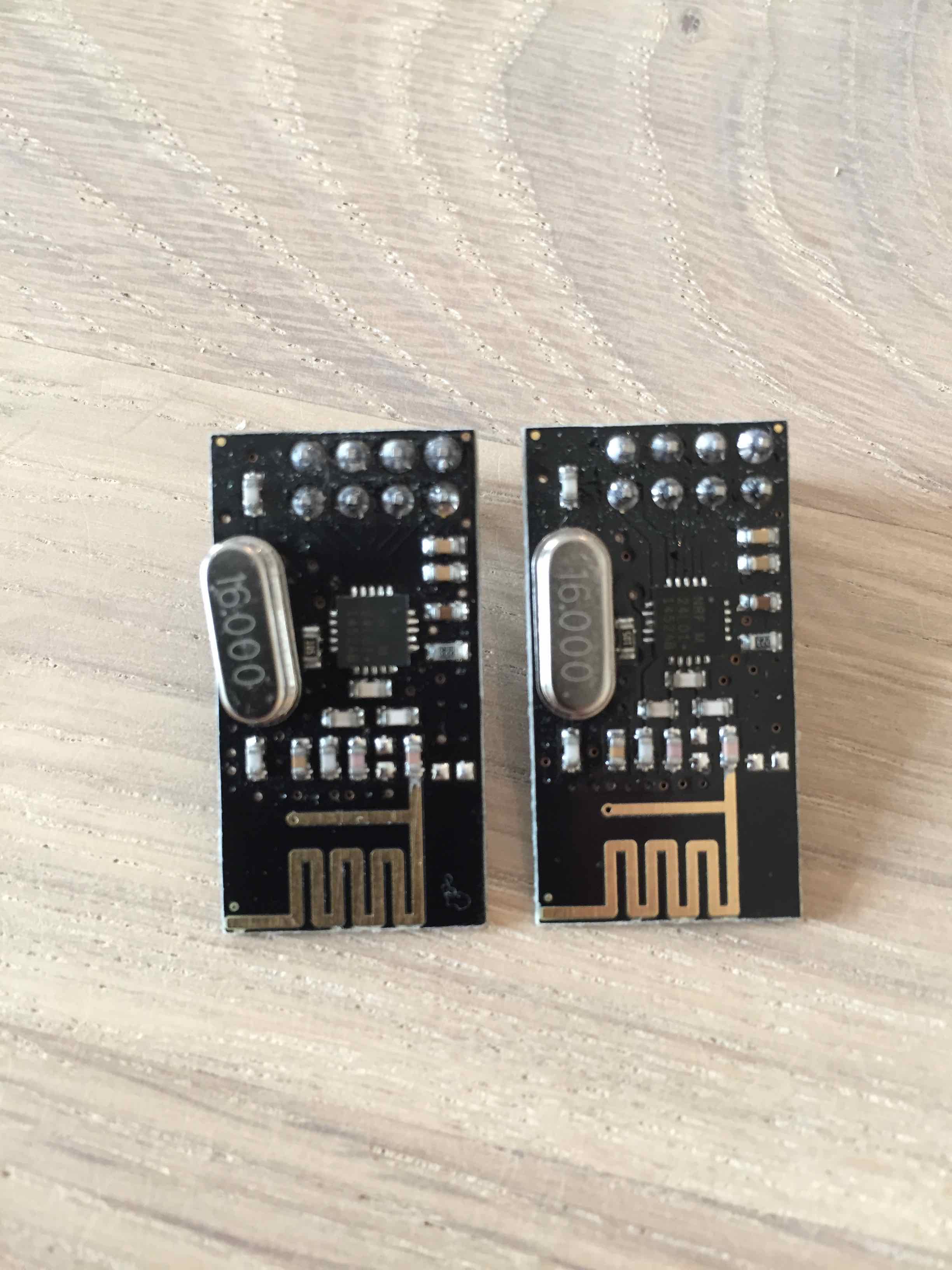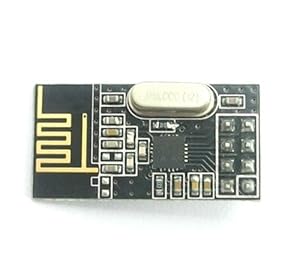Issues with setting up my Arduino Nano SerialGateway
-
Hi,
I have a Arduino Nano (link) bought on eBay. And the NRF24L01 module also bought on ebay (link).
The NRF module do not have any markings of the pins and the ebay product page do not contain any information either. I've therefore assumed that the pins are the same as on the tutorial page (link).
I've uploaded the SerialGateway sketch to the Arduino Nano successfully without any changes. When looking at the Serial Monitor I get this message. "K��0;0;3;0;9;radio init fail" or "�RV��# �0;0;3;0;9;radio init fail" after trying to rewire it all from scratch.
The Arduino Nano have the possibility to output 3.3 and 5 V, I've therefore used the Arduino Nano 3.3v pin rather than the recommended VCC pin (that I assume output 5V). Not sure if this is wrong...
I'm using OSX 10.11.3 and Arduino 1.6.7. Though not sure if that is relevant.
Do you have any tips as to what I'm doing wrong?
-
Hi,
I have a Arduino Nano (link) bought on eBay. And the NRF24L01 module also bought on ebay (link).
The NRF module do not have any markings of the pins and the ebay product page do not contain any information either. I've therefore assumed that the pins are the same as on the tutorial page (link).
I've uploaded the SerialGateway sketch to the Arduino Nano successfully without any changes. When looking at the Serial Monitor I get this message. "K��0;0;3;0;9;radio init fail" or "�RV��# �0;0;3;0;9;radio init fail" after trying to rewire it all from scratch.
The Arduino Nano have the possibility to output 3.3 and 5 V, I've therefore used the Arduino Nano 3.3v pin rather than the recommended VCC pin (that I assume output 5V). Not sure if this is wrong...
I'm using OSX 10.11.3 and Arduino 1.6.7. Though not sure if that is relevant.
Do you have any tips as to what I'm doing wrong?
@Christian-Simonsen Hard to tell. By the looks of the picture of your NFR24L01+ it's the same pinout as on the MySensors build page.
There are a couple of checks that can be done:
- Always power the radio with 3.3V never 5V (which I assume is your VCC pin).
- Add a capacitor (4.7uF) as close to the radio as possible. (I always stick them, in the female pins of the Dupont cable).
- Double check the wiring. Make sure that MOSI and MISO aren't changed e.t.c.
- Select the correct board and processor in your Arduino IDE/
Also set your serial monitor to 115200 baud, to might get rid of the strange symbols in your output. I have a couple of Nano based sensors which are running for more than half a year without any problem.
-
Ref your suggestions.
-
Always power the radio with 3.3V never 5V (which I assume is your VCC pin).
So I guess my wiring is correct then if I understood you correctly. VCC is 5V and should not be used in my case. -
Add a capacitor (4.7uF) as close to the radio as possible. (I always stick them, in the female pins of the Dupont cable).
- I already have a 4.7uF (50V) capacitor between GND and VCC on the NRF board, done the same way as you describe. -
Double check the wiring. Make sure that MOSI and MISO aren't changed e.t.c.
- I've checked the NRF chip on the board and traced the connections to the PIN, and I can verify that the output pins are in the same way as the tutorial linked to above (Chip marking: NRF M 24L01+ 1452AB) - And double checked the wiring, can't find any errors -
Select the correct board and processor in your Arduino IDE/
I uploaded the sketch again to the Arduino, and this removed the strange symbols in the Serial Monitor. Now I get "St0;0;3;0;9;radio init fail".
I've also replaced the NRF module with another one ( I have 10). This didn't work either.
Do I need to change anything in the sketch? eg. the input pins on the Arduino?
By the way - I see no lights (LEDs) or signs that the NRF module receive any power. Not sure if there are any tiny LEDs on it... but it seems like it is..
-
-
In case it was something wrong with the Arduino Nano, I've replaced it and tried another. However Im still getting the same error. "0;0;3;0;9;radio init fail".
-
In case it was something wrong with the Arduino Nano, I've replaced it and tried another. However Im still getting the same error. "0;0;3;0;9;radio init fail".
I have now also tried the long-range version (link) and Im getting the same error. "0;0;3;0;9;radio init fail"
-
I have now also tried the long-range version (link) and Im getting the same error. "0;0;3;0;9;radio init fail"
I've also tried to switch the MISO and MOSI just in case I had got it wrong. No effect. Still the same error.. :( Running out of ideas...
-
I've also tried to switch the MISO and MOSI just in case I had got it wrong. No effect. Still the same error.. :( Running out of ideas...
@Christian-Simonsen what is the log saying when you monitor the gateway with serial monitor?
also query this forum for St0;0;3;0;9;radio init fail. It might help you.
-
@Christian-Simonsen most have been said above, but my thoughts:
Radio init fail means
- Not wired correctly
- Not powered correctly
- Not a nrf24 with +
Do you have a capacitor between grn/vcc on the 3.3v radio? This can make difference...
Some reading regarding + and not + Nrf modules.
http://forum.mysensors.org/topic/1153/we-are-mostly-using-fake-nrf24l01-s-but-worse-fakes-are-emerging/4
http://forum.mysensors.org/topic/1664/which-are-the-best-nrf24l01-modules/2 -
@Christian-Simonsen most have been said above, but my thoughts:
Radio init fail means
- Not wired correctly
- Not powered correctly
- Not a nrf24 with +
Do you have a capacitor between grn/vcc on the 3.3v radio? This can make difference...
Some reading regarding + and not + Nrf modules.
http://forum.mysensors.org/topic/1153/we-are-mostly-using-fake-nrf24l01-s-but-worse-fakes-are-emerging/4
http://forum.mysensors.org/topic/1664/which-are-the-best-nrf24l01-modules/2The chip marking is "NRF M 24L01+ 1452AB" - so I assume it is a + module.
I've tried to rewire it multiple times, I will try again.
-
@Christian-Simonsen - Markings is not a guarantee...
See the threads i posted, there are alot if images.. maybe you can see something there. Or post a picture of your radios here... maybe we can spot something if you suspect its a fake.Also - how do you power your node?
-
I'm using both NRF24L01 and NRF24L01+. You have to change the datarate in the MyConfig to 1mb to be able to do that.
#define RF24_DATARATE RF24_1MBPS
-
@Christian-Simonsen - Markings is not a guarantee...
See the threads i posted, there are alot if images.. maybe you can see something there. Or post a picture of your radios here... maybe we can spot something if you suspect its a fake.Also - how do you power your node?


Fake NRF chips seems like the most plausible reason so far. The chips do look of bad quality.... but whether the chips are the issues or not is difficult to say..
Can you judge from the pictures?
-
No - its not possible to say exacly. Its defenetly a fake - but how bad, not possible to say.
I read some days ago someone recieved a bad batch and there was no silkscreen / white markings just like you. (See image)
but I also recieved a batch yesterday without markings - and the one i used today worked great! -
Ok,
Is there a sketch that I can use that I can use to test/debug the NRF module specifically that might help identify what I am doing wrong or the if the module is bad?
I see some refer to running "Get Started".... but can't seem to find out what they are referring to...
-
Hi,
I found the TMRh20/RF24 library on GitHub and I uploaded the GetStarted sketch to the Arduino. Not sure if it is working but atleast a lot started happening in the Serial Monitor.
RF24/examples/GettingStarted *** PRESS 'T' to begin transmitting to the other node Sent response 16908288 Sent response 0 Sent response 1040677376 Sent response 0 Sent response 671495 Sent response 4294903807 Sent response 50331648 Sent response 50331648 Sent response 65536 Sent response 16777292 Sent response 0 Sent response 33554434 Sent response 0 Sent response 167903239 Sent response 167903239 Sent response 32639 Sent response 2 Sent response 512 Sent response 33554434 Sent response 1057423360 Sent response 1057423360 Sent response 1057161279 Sent response 4294967295 Sent response 0Then I pressed "T" in the Serial Monitor and then this happend:
*** CHANGING TO TRANSMIT ROLE -- PRESS 'R' TO SWITCH BACK Now sending failed Failed, response timed out. Now sending Sent 127157552, Got response 0, Round-trip delay 1730592 microseconds Now sending Sent 129889960, Got response 0, Round-trip delay 3673784 microseconds Now sending Sent 134565556, Got response 0, Round-trip delay 4033292 microseconds Now sending Sent 139600664, Got response 0, Round-trip delay 4093332 microseconds Now sending Sent 144695808, Got response 0, Round-trip delay 16792 microseconds Now sending Sent 145714324, Got response 0, Round-trip delay 3975708 microseconds Now sending Sent 150691860, Got response 0, Round-trip delay 4035408 microseconds Now sending Sent 155729096, Got response 0, Round-trip delay 4196592 microseconds Now sending Sent 160927500, Got response 0, Round-trip delay 3815552 microsecondsTo me it seems to work..
-
Hi,
Now I have also tried the original RF24 library by ManiacBug (link). And I got this results in the Serial Terminal.
STATUS = 0x00 RX_DR=0 TX_DS=0 MAX_RT=0 RX_P_NO=0 TX_FULL=0 RX_ADDR_P0-1 x00 = 0x0000000000 0x0000000000 RX_ADDR_P2-5 x00 = 0x00 0x00 0x00 0x00 TX_ADDR = 0x0000000000 RX_PW_P0-6 x00 = 0x00 0x00 0x00 0x00 0x00 0x00 EN_AA = 0x00 EN_RXADDR x00 = 0x00 RF_CH = 0x00 RF_SETUP x00 = 0x00 CONFIG = 0x00 DYNPD/FEATURE x00 = 0x00 0x00 Data Rate = 1MBPS Model = nRF24L01 CRC Length = Disabled PA Power = PA_MINFrom what I can understand the Arduino is able to send and receive responses (even though I only have one NRFmodule running... so not sure what is given the response to the NRF... )
Now sending 55497...ok...Got response 4294967295, round-trip delay: 55499 Now sending 56500...ok...Got response 4294967295, round-trip delay: 56502 Now sending 57502...failed. Got response 4294967295, round-trip delay: 58083 Now sending 59082...failed. Got response 4294967295, round-trip delay: 59675 Now sending 60675...ok...Got response 4294967295, round-trip delay: 60691 Now sending 61690...ok...Got response 4294967295, round-trip delay: 61692 Now sending 62693...ok...Got response 4294967295, round-trip delay: 62695 Now sending 63695...ok...Got response 4294967295, round-trip delay: 63711On in the other mode I'm getting this...
Got payload 4294967295...Sent response. Got payload 4294967295...Sent response. Got payload 4294967295...Sent response. Got payload 4294967295...Sent response. Got payload 4294967295...Sent response. Got payload 4294967295...Sent responseThe odd part is, why do I then not get the MySensor SerialGateway sketch to work... any thoughts?
-
This isn't working at all. First, yes you have fake chips, I have the same ones, but they work with the RF24 library just fine so far. Second, the payload should be either the current microseconds or a steadily incrementing number. The payload you're getting is the result of either bad power or incorrect pin out to your controller, usually the CE and CSN are wrong.
